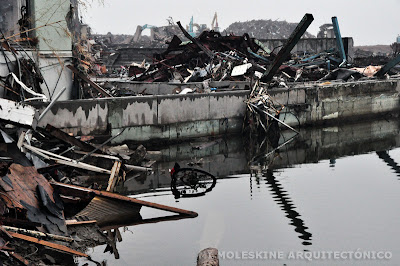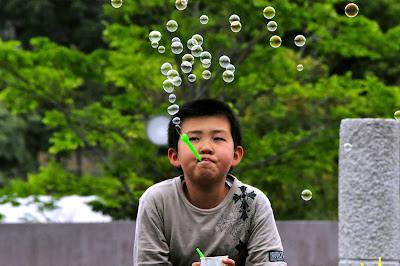ESPAÑOL
Minami Sanriku is the symbol of the devastation that strucked northern Japan on March 11, 2011 . As much as 95% of the village was destroyed and at least 60% of its population perished (10,000 people). The survivors lost everything.
One of the main reasons that led us to this site was to known firsthand the level of destruction experienced by Japan and the world seems to have forgotten, overwhelmed by the far less lethal radioactive problem of Fukushima. In addition, this post is a testimony to the tremendous strength of Japanese people and their level of response to the emergency, the rescue and cleanup efforts and the first plans of rebuilding the affected areas.

EARTHQUAKE
As it is known, on March 11 a huge earthquake hit Tohoku, northeastern Japan, whose intensity (9.0 on the Richter scale) was the highest in the country's history. Japan sits atop the Eurasian tectonic plate and is pushed by the Pacific plate and the Philippines. Every 30 years it is expected an earthquake of 7 to 8 magnitude occur in this area (Miyagi Jishin), due to the tension of the Philippine plate. What no one expected since it happens every 1000 years, is a 9 magnitude earthquake, resulting from the breakup of the Pacific plate (Miyagi Oki Jishin).
However, due to the accurate forecast of Japanese, the earthquake itself did not cause major human and material losses, despite being 1000 times more intense than that of Haiti.

THE GREAT TSUNAMI
Because the frequency of tsunamis in this area, given the intricate coastline profile that reverberates water waves , the coast is protected by dikes and barriers up to 4 m. However, the strength of the earthquake made the whole coast to sink up to 1 m. Besides, nobody could expect the super wave of 7 m that exceeded the concrete defenses as if they not exist at all. Moreover, given the strength of the tsunami, large blocks of those defenses were launched like missiles into the wooden houses that were standing on the shore.

MINAMI Sanriku
Sanriku Minami, a fishing village resort, is located in an elongated plain in the mouth of three rivers, which run by two narrow valleys. A promontory of 3 m above sea level is the highest point of the city.

 Minami Sanriku tsunami before and after. Only a quarter in the upper left corner, being a little higher and between two hills, survived.
Minami Sanriku tsunami before and after. Only a quarter in the upper left corner, being a little higher and between two hills, survived.After experiencing an earthquake for five long minutes, Miki Endo, a worker Disaster Welfare Service received a tsunami alert and began to broadcast alarm messages to the population. Many people then went to look safety on the roofs of the few tall buildings in town. Others tried to escape by car, causing heavy congestion in the narrow streets of the village.
40 minutes later, a big wave came to town, dragging everything in its path, and becoming a deadly wall of debris, cars and boats that reached a speed of 100 km per hour.
A video of the impact of the tsunami in Sanriku Minami.
The narrow streets channeled this deadly fluid , which reached 16 m in height.
 These photos were taken on the roof of the Center for Disaster Prevention, 3 stories high. Only two people survived, clinging to the building's radio antenna .
These photos were taken on the roof of the Center for Disaster Prevention, 3 stories high. Only two people survived, clinging to the building's radio antenna . The public servant heroically continued broadcasting without trying to seek refuge, managed to save many lives, until she was engulfed by water. Many who were on the roof had no better luck. At least 31 of the 80 sites designated for evacuation were flooded.

 Disaster Prevention Center, before and after the impact of the tsunami. Notice how before the building was part of a compact urban landscape.
Disaster Prevention Center, before and after the impact of the tsunami. Notice how before the building was part of a compact urban landscape. After wiping out the village, the tsunami followed the course of rivers. We could see that the water line reached at least 20 meters, ranging up to 3 miles inland. But the nightmare did not ended there, because of the strength with which the wave back to sea, dragging everything in its path.

Those who survived and were trapped under the rubble and into the car, died later from hypothermia. It was March, and the Sendai area is particularly cold.
Still, special teams managed to rescue 500 survivors in an impressive display of organization and even acrobatics. He quickly organized refugee areas, tents and mobile hospitals. However, the panic Fukushima radiation resulted in shortages of food, water, batteries, blankets, etc.. and exaggerated paranoia of the international press on this issue prevented the competition from thousands of volunteers and rescue workers from around the world, when they were most in need.

2 MONTHS LATER.
Two months later, I am standing in front of what was Minami Sanriku and this view reminds me of the pictures he saw in Hiroshima showing the destruction of the city after the atomic explosion.
The remains of one or another building, dotted with mountains of trash and junk unrecognizable tangle of twisted cars once were. One is located on the roof of a building of 3 stories or 10 feet high. I've never seen anything like it.
The thick haze seems to still carry thousands of moans, cries and tears of so many people, and crawls, wailing, making us breath the scent of the tragedy.


But I was also impressed by the organizational capacity of the Japanese people. The first thing they have done is to restore and clean all the roads. Sendai Airport, despite the damage it suffered, has been put into operation in record time. Not only in Minami Sanriku but in other villages visited as Nobiru, there are huge piles of rubble wrought by cranes, equivalent to the garbage that would have been collected in 23 years. In many places the waste is classified and the cars, buses and boats are packed in rows of junk.
 The automobiles are stacked together in large junkyard. Many of them were new or were ready for export.
The automobiles are stacked together in large junkyard. Many of them were new or were ready for export.In other areas the machine proceeded to demolish the dilapidated buildings half, leaving a vast plain, there will surely be starting from scratch for the new city planning.
In addition to locating settlements a little higher and create multiple defense systems on the coast, I guess one of the aspects to be taken into account by planners will be to provide wide escape routes. The tsunami warning system worked on time, but many could not escape being caught in traffic congestion.
There will be plenty to do in the field. Growing areas (agriculture is an important economic activity in the area) have been ruined by salt from seawater, desalination and take a long time these soils.
We also visited refugee areas, particularly one located next to a museum (it is astonishing how the ancient people of the Jomon era lived in high places, and this is due to the presence of strong tsunamis several thousand years ago, as they have excavation shown).

We chatted with the volunteers who are trying to bring joy to a group of children (many of them orphaned, since schools were located in places a little higher). There has been much international aid, at least not in proportion to the magnitude of the disaster (there is a traveling hospital donated by Israeli cooperation). But the whole Japan has joined to help. We are told that money is not the only thing what they need. Perhaps most important are the voices of encouragement.


In the coming months I look forward to the disaster area so you can share with reconstruction efforts in the area. Until then.








